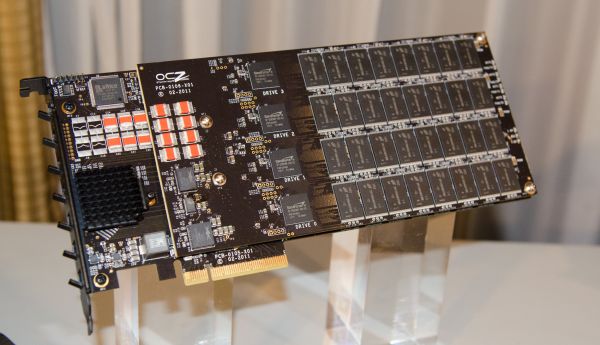Computex 2011: OCZ Z-Drive R4 88, Eight SF-2281 Controllers in RAID-0
by Anand Lal Shimpi on May 31, 2011 10:06 AM EST- Posted in
- Trade Shows
- SSDs
- SandForce
- OCZ
- SF-2000
- Z-Drive R4
- Computex 2011
OCZ's consumer accessible PCIe SSD line is the RevoDrive, but if you're an enterprise customer and want a custom configuration OCZ will build you a Z-Drive. To show you how far OCZ is willing to go, it announced a brand new Z-Drive at Computex: the R4 88.
Take eight SF-2281 controllers, put them all in a RAID-0 on a PCIe x8 card with an as-of-yet unknown controller and you've got the Z-Drive R4 88:
OCZ will be offering two types: the C Series and the R Series. The C Series has less over provisioning and lacks any polymer capacitors for power loss protection, while the R Series has more NAND set aside as spare area and comes equipped with some form of protection against sudden power loss.
OCZ had a 3U Colfax server with multiple Z-Drive R4 88s running an Iometer 4KB random read test, the end result was a single server that delivered more than 1 million IOPS. The drive is spec'd for up to 2.9GB/s reads and 2.7GB/s writes. Obviously as an 8-way RAID-0 there are reliability concerns and I'm not exactly sure the type of enterprise customer that would deploy such a thing, but it's a neat drive to look at nonetheless.

















13 Comments
View All Comments
GullLars - Tuesday, May 31, 2011 - link
Comparing this to a Fusion-IO ioDrive is like comparing a Vespa to a Hayabusa...The ioDrive is designed from a completely different mindset, and the performance is not comparable by max throughput numbers. It acts as a memory array rather than a block storage device.
You have 2 sides of performance, throughput and latency. The ioDrive has latency roughly 3 times lower than this, making it more similar to SATA/SAS based RAM drives than (any interface) flash drives.
What this means in practice is that in order to reach the same throughput, Z-drives will need roughly 3 times higher (or more) queue depth, and will deliver a lower QOS (quality of service) because of IO latency at any given throughput or queue depth.
You COULD think of this as a "poor man's ioDrive". But for those purposes, a LSI or Areca card with a large array of good SATA/SAS SSDs will do the same job with more flexibility.
I have an array from my southbridge that can push 1200MB/s sequential and 100.000 4KB random IOPS. It cost me under $1000 this fall. Incidentally it also allowed me to get the PCMark Vantage world record for AMD systems, with only air cooling.
eirikma - Tuesday, May 31, 2011 - link
if you use it to speed up software build farms and other "churning" tasks that only chew through data / source code that is taken from a safe location and copied onto another safe location when done. Intermediate results are in such cases dispensable, but median time-to-build is critical for overall development speed, costs and time-to-market.At over 900000 you should speed up a fairly large team by a considerable amount, though....
63jax - Wednesday, June 1, 2011 - link
well not good for me, too cheap, i think i'll buy an ioDrive Octal...:))